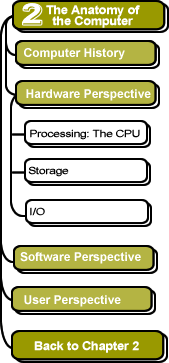

|
Input Devices
The internal operations of the computer intersect with the world of the user at the input and output devices attached to the computer.
Let's first consider the idea of input.
As we have learned, the only thing a microprocessor does is to mimic binary arithmetic. In the most fundamental terms, input is simply the task of sending binary arithmetic tasks to the microprocessor.
Fortunately, the user has a splendid array of input devices that take care of encoding binary instructions to be sent to the microprocessor. For instance:
-
 The
computer keyboard converts alphanumeric characters
(letters, numbers, punctuation marks, and other "typewriter"
characters). Depressing a key causes 0s and 1s —in
the form of high or low voltages on wires—
to be sent to the microprocessor.
The
computer keyboard converts alphanumeric characters
(letters, numbers, punctuation marks, and other "typewriter"
characters). Depressing a key causes 0s and 1s —in
the form of high or low voltages on wires—
to be sent to the microprocessor.
-
The computer mouse falls into the category of a pointing device. Moving the mouse causes 0s and 1s, describing the measurements of movement of the mouse, to be sent to the microprocessor. A computer joystick works in a similar way.
-
A microphone picks up sounds and turns them into 0s and 1s via a sound card or similar hardware. Voice-recognition software, which maps certain sounds to certain commands, enables a user to give voice instructions to the system.
![]()
![]()
These pages were written by Steven H. VanderLeest and Jeffrey Nyhoff and edited by Nancy Zylstra
©2005 Calvin University (formerly Calvin College), All Rights Reserved
If you encounter technical errors, contact computing@calvin.edu.